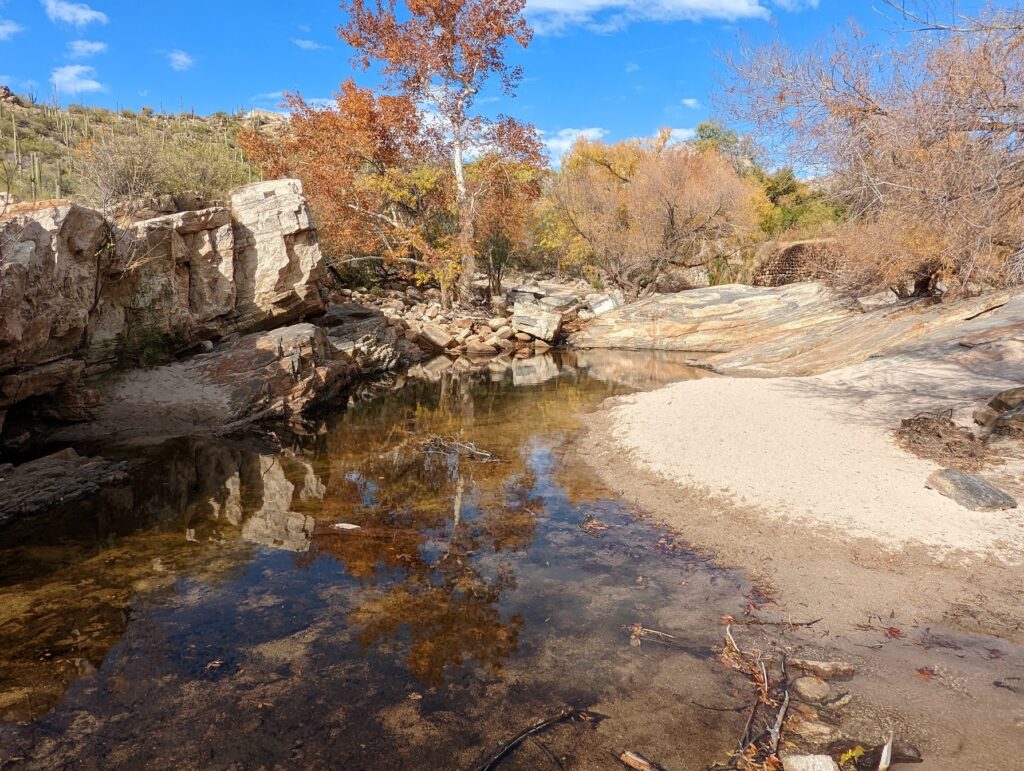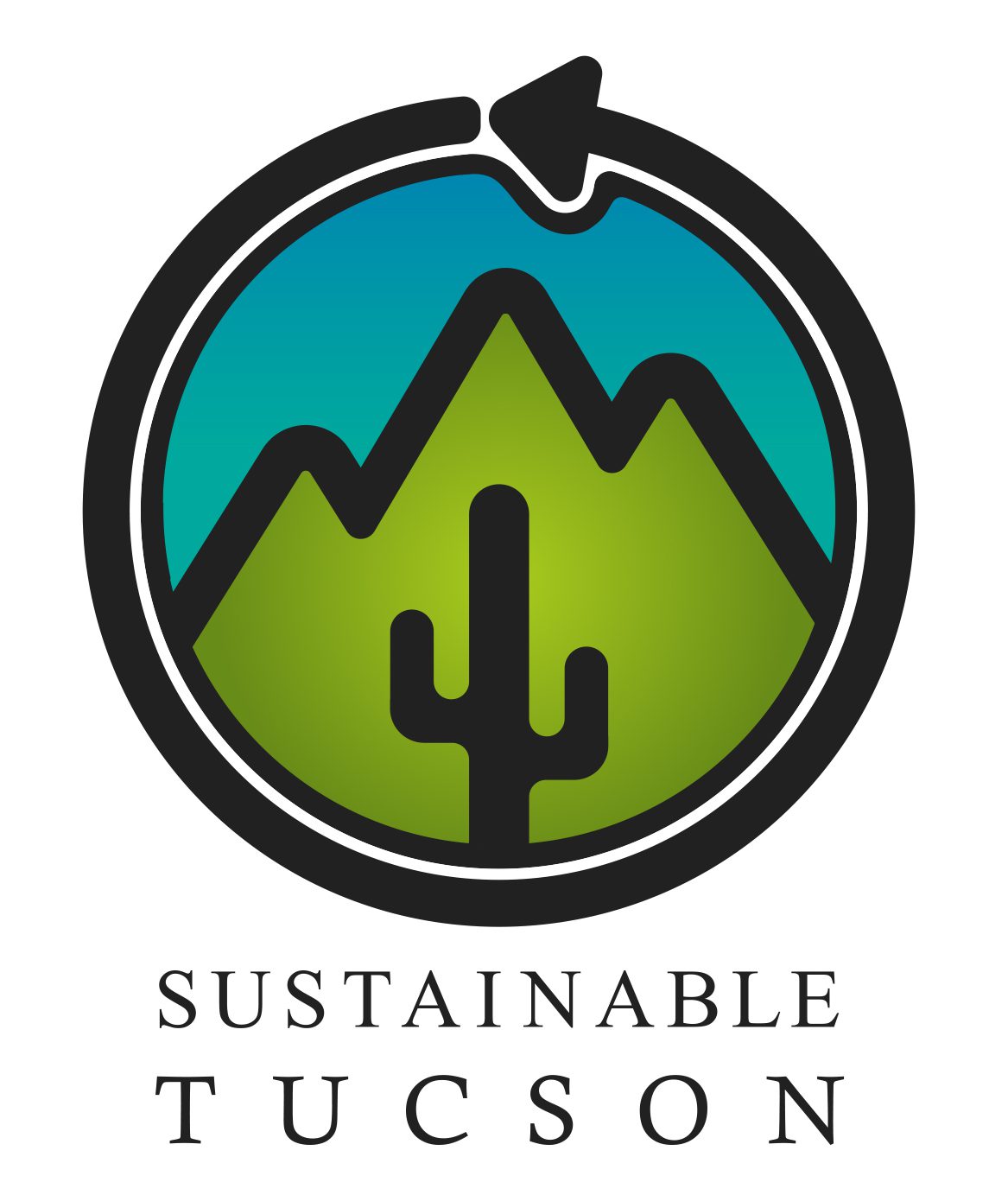
Some people think that there is no water in Tucson. But there are seasons when our desert has an overabundance. In the winter months, there is snow on some of the five mountain ranges that surround Tucson. In the spring, icy water bounds down the Catalina Mountains into rushing rivers and streams. During Monsoon season, our washes rage and overflow.
But as climate change progresses, there are more and more days when our rivers are bone dry. Not enough of this water sinks into our aquifer since so much of our land is covered with asphalt and cement. Instead our precious rainwater puddles in city streets and evaporates. Lack of foresight and understanding have left us with no infrastructure to retain that water for our daily use.
It wasn’t always that way. Native Americans and Mexicans settled here for the abundant Santa Cruz river water. Tucson is one of the oldest settlements in the country. As early as 2,100 BCE there were villages along the Santa Cruz River. Native Americans have continuously inhabited this arid region from prehistoric times to today, pioneering water harvesting and dryland farming techniques and creating the oldest known irrigation canals in North America.The Hohokam created an elaborate irrigation system connected to the river. They captured rainwater with terraces and rock dams. The Tohono O’odham crafted earthen dams and brush weirs to divert water from washes to crops.
It wasn’t that long ago that our rivers and streams flowed year round. Along the river was a lush riparian habitat. The giant cottonwood trees that flanked the river and a massive mesquite bosque were homes for a diverse array of wildlife. That was before grazing, farming, mining, a lumber mill, and just plain bad management depleted the groundwater and turned those rivers into dry river beds that flow mainly when it rains.
Throughout the 20th century, Tucson relied on groundwater for its growing population. Over-pumping dried up springs, wells, and creeks including the Santa Cruz river. We used up the water in the aquifer faster than it could be replenished, so the land in some areas began to subside, putting buildings and infrastructure at risk. In response, the City of Tucson purchased farmlands in the Avra Valley during the 1960-70s to save water rights and retire them to stop further groundwater pumping.
So where does Tucson get its water?
Currently 326 miles of cement aqueducts transport CAP water from the Colorado River. We share that water with seven other states and Mexico.
That water was over-allocated from the beginning. Over-pumping, drought and climate change depleted the Colorado River (that is Tucson’s main source of water.) We are currently experiencing a serious water shortage. A tier 2a water shortage was announced for 2023. The Colorado River water is stored in Lake Mead and Lake Powell. Both lakes are experiencing record lows. If the water drops below a certain level, we won’t be able to pump water from Lake Mead.
To make matters worse, California has senior water rights among the lower basin states (which include Arizona, Nevada, New Mexico, and Mexico). While our largest cities in the Active Management Areas (AMAs)Tucson and Phoenix, and the tribes get first dibs on our allotment of CAP water, rural areas and farms will experience major cutbacks. That’s a problem because 70 percent of the state’s water goes to agriculture. Unfortunately, there are no rules to prevent industrial farms from over-pumping water. While there are rules requiring a 100 year supply of water in Active Management Areas, there are no such restrictions for rural areas. As a result, over-development threatens the aquifers that supply water to our last flowing rivers – like the San Pedro River.
Fortunately, Tucson Water anticipated this issue and stored extra CAP water in our aquifer.
On retired farm land in Avra Valley, large basins are used to recharge excess Colorado River water into the aquifer. They act as a “savings account,” or backup supply to draw on in drier years. Since we stopped pumping so much local groundwater, aquifers have begun to recover, rising more than 100 feet near downtown.
Tucson is known for its water conservation efforts including supplying rebates for high-efficiency toilets and washing machines, greywater systems, and rainwater harvesting cisterns and catchment basins. The average Tucson resident uses 74 gallons of water a day – compared with Phoenix’s 94 gallons per person daily. The statewide average is 146 gallons! About 20 percent of the state’s water supply is for municipal use and most of that is residential. Up to 70 percent of that water is used outdoors (watering plants, swimming pools, washing cars, etc.)
To conserve water, Tucson also implemented a Green Stormwater Infrastructure (GSI) policy. Street side curb-cuts direct water into catchment basins to nourish native trees that shade streets and sidewalks. This puts to good use the stormwater that collects in city streets. In response to the disastrous flood of 1983, our current flood control system was implemented. Some of our busiest streets were designed to act as streams directing the water to the rivers.
In 1984, Tucson became one of the first communities in the nation to recycle treated wastewater at a large scale for landscape irrigation for parks and golf courses. This system has grown to one of the largest in the country. In 2019, some of that treated water was released into the Santa Cruz River to replenish the riparian habitat and the aquifer. The Santa Cruz now flows for about a mile near downtown Tucson.
Underutilized water source
The good news is that there is enough annual rainfall to supply every Tucsonan’s water needs – if we harvest the stormwater. While the city and county work on their own green infrastructure improvements, we can incorporate rainwater harvesting features that keep the water in our yards to irrigate our native landscapes, edible forests and drought tolerant gardens.
The first step is embracing the nature of the desert we inhabit. Stop trying to force it into something it’s not. Stop bulldozing it and paving it over for perpetual development. Shut off the sprinklers that water those little patches of grass in front of businesses. Manicured lawns don’t belong in the desert – native plants and grasses do.
Watershed Management Group and Sonora Environmental Research Institute (SERI) inspire local homeowners and businesses to develop more sustainable landscaping. They offer free classes on rainwater and greywater harvesting.
Rainwater harvesting methods, such as diverting roof water to mulch covered catchment basins, conserve city water. That allows groundwater to remain in the aquifer which in turn supports surface flow in our streams.
If you wanna see how it’s done, you can tour Watershed Management Group’s Living Lab and Learning Center – our own little oasis in the desert. Using a combination of cisterns and earthworks, WMG harvests enough rainwater (during a regular rain year) to meet all of their needs – including irrigating some fruit trees!
